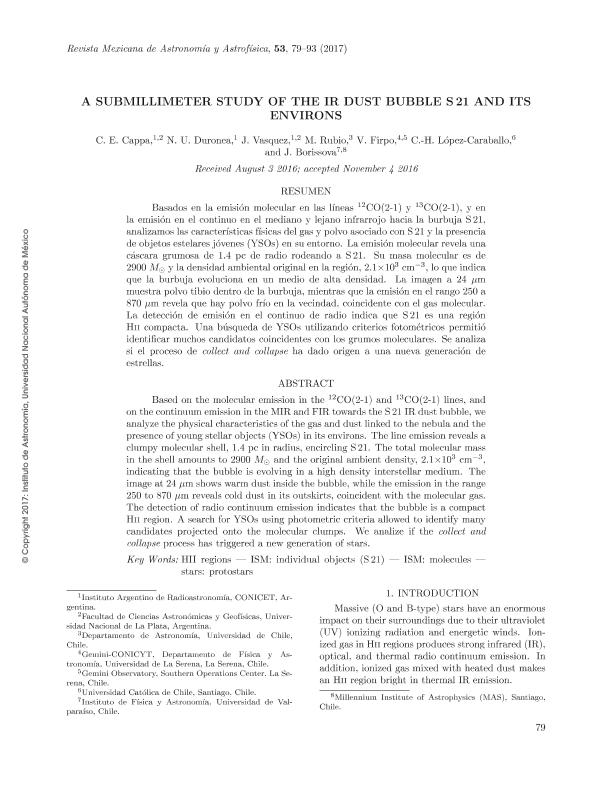Artículo
Based on the molecular emission in the 12CO(2-1) and 13CO(2-1) lines, and on the continuum emission in the MIR and FIR towards the S 21 IR dust bubble, we analyze the physical characteristics of the gas and dust linked to the nebula and the presence of young stellar objects (YSOs) in its environs. The line emission reveals a clumpy molecular shell, 1.4 pc in radius, encircling S 21. The total molecular mass in the shell amounts to 2900 M⊙ and the original ambient density, 2.1 ×10 3 cm − 3 , indicating that the bubble is evolving in a high density interstellar medium. The image at 24 µm shows warm dust inside the bubble, while the emission in the range 250 to 870 µm reveals cold dust in its outskirts, coincident with the molecular gas. The detection of radio continuum emission indicates that the bubble is a compact Hii region. A search for YSOs using photometric criteria allowed to identify many candidates projected onto the molecular clumps. We analize if the collect and collapse process has triggered a new generation of stars. Basados en la emisión molecular en las líneas 12CO(2-1) y 13CO(2-1), y en la emisión en el continuo en el mediano y lejano infrarrojo hacia la burbuja S 21, analizamos las características físicas del gas y polvo asociado con S 21 y la presencia de objetos estelares jóvenes (YSOs) en su entorno. La emisión molecular revela una cáscara grumosa de 1.4 pc de radio rodeando a S 21. Su masa molecular es de 2900 M⊙ y la densidad ambiental original en la región, 2.1 ×10 3 cm − 3 , lo que indica que la burbuja evoluciona en un medio de alta densidad. La imagen a 24 µ m muestra polvo tibio dentro de la burbuja, mientras que la emisión en el rango 250 a 870 µm revela que hay polvo frío en la vecindad, coincidente con el gas molecular. La detección de emisión en el continuo de radio indica que S 21 es una región Hii compacta. Una búsqueda de YSOs utilizando criterios fotométricos permitió identificar muchos candidatos coincidentes con los grumos moleculares. Se analiza si el proceso de collect and collapse ha dado origen a una nueva generación de estrellas.
A submillimeter study of the IR dust bubble S 21 and its environs
Cappa, Cristina Elisabeth ; Duronea, Nicolas Urbano
; Duronea, Nicolas Urbano ; Vasquez, Javier
; Vasquez, Javier ; Rubio, M.; Firpo, V.; López Caraballo, C. H.; Borissova, J.
; Rubio, M.; Firpo, V.; López Caraballo, C. H.; Borissova, J.
 ; Duronea, Nicolas Urbano
; Duronea, Nicolas Urbano ; Vasquez, Javier
; Vasquez, Javier ; Rubio, M.; Firpo, V.; López Caraballo, C. H.; Borissova, J.
; Rubio, M.; Firpo, V.; López Caraballo, C. H.; Borissova, J.
Fecha de publicación:
04/2017
Editorial:
Universidad Nacional Autónoma de México
Revista:
Revista Mexicana de Astronomía y Astrofísica
ISSN:
1405-2059
Idioma:
Inglés
Tipo de recurso:
Artículo publicado
Resumen
Palabras clave:
Interstellar Bubbles
,
S21
,
Interstellar Medium
Archivos asociados
Licencia
Identificadores
Colecciones
Articulos(IAR)
Articulos de INST.ARG.DE RADIOASTRONOMIA (I)
Articulos de INST.ARG.DE RADIOASTRONOMIA (I)
Citación
Cappa, Cristina Elisabeth; Duronea, Nicolas Urbano; Vasquez, Javier; Rubio, M.; Firpo, V.; et al.; A submillimeter study of the IR dust bubble S 21 and its environs; Universidad Nacional Autónoma de México; Revista Mexicana de Astronomía y Astrofísica; 53; 1; 4-2017; 1-15
Compartir



